
Image Credit: way4arer/Shutterstock.com
Developers and engineers have been working towards the goal of a functioning humanoid robot for decades. The first full-scale humanoid robot was the WABOT-1, shown in 1973 at Waseda University in Tokyo, and they have come a long way since then.
There have been major advances in this technology. They may be seen at science fairs and on television, but they have not yet made their presence felt in the real world.
Building a bipedal humanoid robot has presented many challenges. Developing anything even close to a human gait has been a major issue, not to mention the difficulties of articulated hands.
Humanoid robot development has brought together both software developers and many engineering specialties whose expertise has been vital in solving these varied problems.
There is another issue that is confounding developers. How can an autonomous, untethered robot with significant power requirements be provided with the energy it needs for a long period of time?
Battery efficiency more than any other factor has limited the usefulness of robots in daily life and a humanoid robot is very energy hungry. Including additional batteries means introducing more weight which seems to defeat the object. To be useful, a walking robot needs to be operational for the length of time that it is required to perform a given task.
The U.S. military requires autonomous robots that can operate for 10 hours on batteries. Boston dynamics humanoid robot ‘Atlas’ is powered by a 3.7 kWh lithium-ion battery that lasts an hour if the machine is carrying out ‘mixed tasks’ including walking, climbing, and using tools.
Given that these tasks could require the robot to be some distance away from a replacement power source and ultimately will be required to function on long term missions in space, it is clear that a renewable energy source is required.
The most well-known renewable power sources are wind and solar power but using these sources to recharge conventional batteries is wasteful and time-consuming.
There have been many recent innovations in battery technology that might make them a more attractive option for robotics. ‘Ionic Materials’ have developed a revolutionary solid-state lithium battery technology that is cheaper and longer-lasting. Unlike lithium-ion batteries that contain a liquid electrolyte, this battery uses a solid polymer electrolyte.
Using metal lithium rather than lithium ions gives five to ten times the energy density, delivering up to ten times the time to recharge a lithium-ion battery of the same size.
An Israeli startup company, Phinergy, offers an alternative to lithium that might have robotic applications. Their proprietary aluminum batteries produce energy through a reaction between oxygen and aluminum using water.
A more efficient alternative is offered by fuel cells. Fuel cells are simple electrochemical devices. They do not have the low energy densities and high rates of self-discharge found in batteries and they convert chemical energy into electricity.
Unlike a battery, fuel cells need a constant supply of fuel and oxidant to produce electricity. Proton Exchange Membrane (PEM) fuel cells are particularly attractive for robotics. They consist of simple solid-state components that have been sandwiched together.
They function by combining hydrogen fuel, and oxygen (from breathing air) through the most energy-releasing reaction known, to produce electricity and water. It has been shown that PEM fuel cells can reach 65 to 70 % or higher operating efficiencies at room temperature and produce clean water exhaust.
They do have certain disadvantages. Though they are high energy, they are relatively low power and humanoid robots may require short bursts of peak power during a task. They are also less robust which makes them less reliable.
A solution is to develop a battery fuel cell hybrid power source that combines the best of both systems, with the fuel cell recharging the battery during idle times. Recent developments in producing biologically synthesized hydrogen, that are far more efficient than the current process, are set to make hydrogen a more available renewable resource.
The ultimate autonomous self-powering robot is hinted at in the development of EcoBot-II. The robot is designed to power itself solely by living off its environment. It converts unrefined insect biomass into useful energy by using onboard microbial fuel cells with oxygen cathodes.
Different ‘fuels’ (sugar, fruit, and dead flies) were trialed in the microbial fuel cell system. Their efficiency of conversion to electricity as compared to the maximum available energy calculated from bomb calorimetry trials.
In endurance tests, EcoBot-II was able to run for 12 days while carrying out phototaxis, temperature sensing, and radio transmission of sensed data approximately every 14 minutes.
It could be possible that the most efficient renewable fuel for a humanoid robot is maybe not too dissimilar to the organisms that fuel humans.
Sources and Further Reading
Disclaimer: The views expressed here are those of the author expressed in their private capacity and do not necessarily represent the views of AZoM.com Limited T/A AZoNetwork the owner and operator of this website. This disclaimer forms part of the Terms and conditions of use of this website.